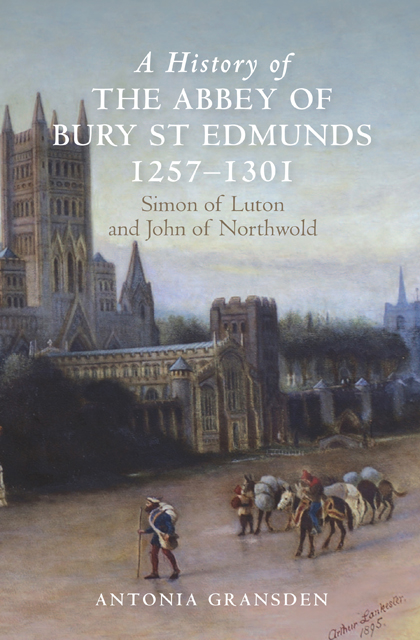Book contents
- Frontmatter
- Dedication
- Contents
- List of plates
- List of figures
- Preface
- Editorial note
- Dedication
- Acknowledgements
- Abbreviations
- Maps and plans (figures 1–11)
- Part I Introduction
- Part II Abbatial Governance
- Part III The Abbey’s Economy
- Part IV Religious Life and Reform
- Part V Intellectual and Cultural Life
- Appendix I The identity of the abbot’s justices, Henry of Guildford and Henry of Shenholt (in 1287)
- Appendix II The monks’ dietary regime: their food and drink
- Select List of the Registers and Customaries Cited
- Select List of Further Manuscripts Cited
- Select Bibliography
- Index
- Backmatter
15 - Loss and Recovery
Published online by Cambridge University Press: 22 February 2023
- Frontmatter
- Dedication
- Contents
- List of plates
- List of figures
- Preface
- Editorial note
- Dedication
- Acknowledgements
- Abbreviations
- Maps and plans (figures 1–11)
- Part I Introduction
- Part II Abbatial Governance
- Part III The Abbey’s Economy
- Part IV Religious Life and Reform
- Part V Intellectual and Cultural Life
- Appendix I The identity of the abbot’s justices, Henry of Guildford and Henry of Shenholt (in 1287)
- Appendix II The monks’ dietary regime: their food and drink
- Select List of the Registers and Customaries Cited
- Select List of Further Manuscripts Cited
- Select Bibliography
- Index
- Backmatter
Summary
When Abbot John assumed office in 1279, he inherited the problems of the abbey’s indebtedness, as well as the effects of taxation and of the other fiscal burdens imposed on the abbey. How he and the convent responded, must be discussed. First, however, another blow to the abbey’s economy, the loss of two of the cellarer’s manors, should be mentioned. On 15 January 1287, Solomon of Rochester and his colleagues, king’s justices in eyre, sat at Cattishall to determine pleas arising in the Liberty of the eight and a half hundreds. John of Creak (‘de Creyk’), Ralph de Berners and Godfrey de Beaumont (‘de Beaumund’) laid claim to the manors of Semer and Groton from the abbot of St Edmunds. The case is of especial interest because Abbot John and the convent chose trial by the antiquated procedure of judicial combat rather than by the then normal procedure of trial by assize, that is, by jury. The outcome of a duel was extremely chancy, and the hiring of a good champion extremely expensive; there was, in addition, the cost of the champion’s and his trainer’s keep during the period of training preceding the duel. Abbot John hired a champion called Roger Clerk, from the Lincoln area, and paid him 20 marks ‘from his own money’, promising him 30 marks more after the duel. The chronicler explains why the abbot and convent chose to defend their right by duel rather than by assize. The jury would have been recruited from local men ‘and we suspected that the surrounding district supported and were in league with our opponents (‘patriam habentes suspectam utpote aduersariis nostris familiarem et affinem’). Besides doubts about the impartiality of a jury, there may have been another reason for preferring the hazards of a duel. The abbey’s title to the manors was insecure. The claimants traced their right back to Nesta (alias Margaret) of Cockfield by (indirect) descent. Abbot Samson had failed in the king’s court to prevent Nesta holding the manors from the abbot in hereditary fee. In the event, the choice of trial by combat was unfortunate.
- Type
- Chapter
- Information
- A History of the Abbey of Bury St Edmunds, 1257-1301Simon of Luton and John of Northwold, pp. 141 - 146Publisher: Boydell & BrewerPrint publication year: 2015



